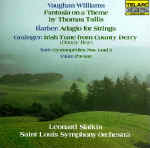You are reading the older HTML site
Positive Feedback ISSUE 5
february/march 2003
Music Review: Ralph Vaughan Williams Fantasia
on a Theme by Thomas Tallis
by Corno de Basetto

"Serene, mystical, introspective, reflective, contemplative, sacred, passionate, meditative, ecstatic, erotic." These are states of mind and body used to describe the listener’s response to Ralph Vaughan Williams Fantasia on a Theme by Thomas Tallis. For me, the work is all of these and more. Representing much of what I find vital about music, this 14 minute piece binds together generations and centuries. It provokes notions concerning the meaning of beauty, the passage of time and civilizations. It is high musical Art.
The Fantasia was composed by Vaughan Williams in 1910 for the Three Choirs Festival in Gloucester Cathedral. The composer noted the Tallis hymn when editing The English Hymnal in 1906. It had first appeared as one of nine new tunes to Archbishop Matthew Parker’s Whole Psalter Translated into English Metre It is in the Phrygian mode and is a verse paraphrase of Psalm 2, "Why do the heathen rage and the people imagine a vain thing?" The particular modal qualities of the tune not only allowed Vaughan Williams considerable harmonic freedom but made possible the prevailing impression of the work: the feeling of timeless coexistence of the ancient and modern.
The forces for which the work is scored are unique. Firstly there is the string section of the modern orchestra (40-50 players); then the "distant" choir of 9 strings (2 first and second violins, 2 cellos and violas, and one double bass); and lastly the solo string quartet. The effect produced by the harmonies created has been likened to the sound of a 3 manual organ filling the space of a cathedral, as well as the span of time between the 16th and 20th centuries.
The music is provocative, challenging and hauntingly beautiful. I have known this work for over 50 years. It continues to be like a river flowing: fresh, changing; not quite the same as remembered the last time encountered. There is a sense of discovery about the piece that is ever rewarding.
Forty five years ago I saw the Tallis Fantasia performed by the New York Philharmonic in Carnegie Hall, conducted by Dimitri Mitropoulos. That performance was very special. While in no cathedral, the sound of the strings of the New York Philharmonic swelled and seemed to resonate with the structure of Carnegie Hall so that it became the great cathedral needed to accommodate that sound and feeling of this music. This performance was later recorded by Columbia records in early stereo coupled with an equally dazzling interpretation of Schoenberg’s Transfigured Night. It is not available in CD format at this time.
I rarely play the vinyl recording in order to preserve it. I listen instead to CDs by Adrian Boult, London Philharmonic (EMI CDM 64017) John Barbirolli, New Philharmonia (EMI CDM 67264) or the 1955 EMI Great Recordings of the Century Von Karajan Philharmonia CD with the wonderful Benjamin Britten Variations on a Theme by Frank Bridge and the Stravinsky Jeu des Cartes. The Philharmonia under Karajan created special chemistry. The Vaughan Williams is a prime example.
Get to know this marvelous piece of music. You will be rewarded many times the 14 or so minutes borne by the Tallis. It is, for me, truth and beauty.
